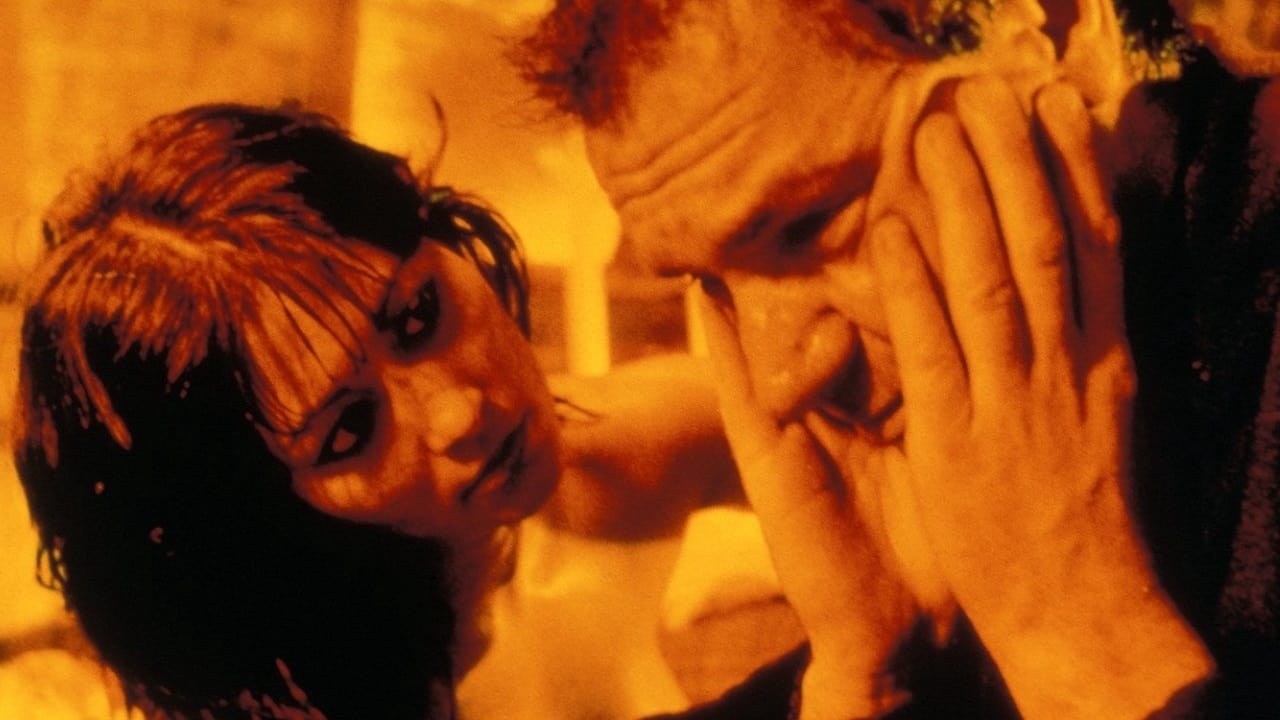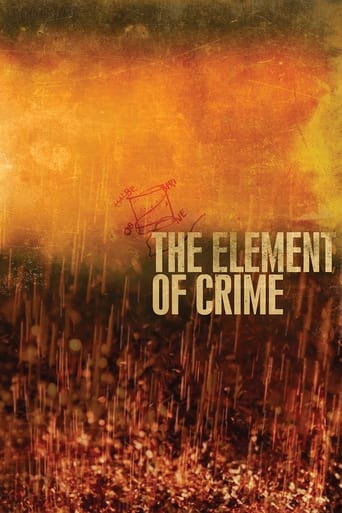KnotMissPriceless
Why so much hype?
Incannerax
What a waste of my time!!!
PlatinumRead
Just so...so bad
Abegail Noëlle
While it is a pity that the story wasn't told with more visual finesse, this is trivial compared to our real-world problems. It takes a good movie to put that into perspective.
Dr Jacques COULARDEAU
The first thing to say concerns the atmosphere and the style of the film. It is bleak. It is dark. The only color is a few dots of red in a lot of black. We are always or nearly always underground, in tunnels, galleries, with running water, in sewers or equivalent places. It is always the night with just some red lights or fire cutting the darkness. Then when we are inside some buildings they are just like outside, in ruins, dirty, bleak, dark, bad hotels when it is not some kind of indescribable refuge for human rats. It is supposed to be Europe, some reduce it to Germany, after WW2 and it is just a vast wasteland abandoned to its own irreversible decay.The characters are two let's say ex-cops. One, Osborne, has fallen out of grace though he is the head and thinker of the film, and the other one, Fischer, is an ex-cop who ran away from police work to find some peace in Cairo. One day he accepts to be hypnotized by a doctor to try to find some solution to a case that is haunting him. This explains the blurred and fuzzy images, the lack of details and the concentration on desolation and a few details here and there that are hardly visible and recognizable or identifiable. The only interest of the film, apart from this dystopian if not suicidal vision of Europe, is that Osborne advocates a special method to deal with serial killers. You have to enter their minds and penetrate their motivations. Why do they do this, why do they do it like that, and thus understand every single detail of the pattern of serial killers because they follow patterns. This is profiling as it was at the time devised by the FBI in Quantico. But the film shows that the cop runs a risk: he will little by little get into the tracks if not the footsteps of the killer in order to stop him by knowing what his next crime will be. He thus becomes the serial killer, and not only in a way, in reality. He has to stop and he did stop just in time. I am not sure that the fact the prostitute he uses all along has had a child by the killer Harry Grey adds anything to the plot except that Fischer is thus put some more in the position and even place of the killer to make us even doubt whether he is not the killer himself. That's the five seconds of tragedy, or rather melodrama. Of course we do not really know what is the past, what is the hypnosis or what is a new trip to Europe. Chronology is not important at all.A film that is difficult to really penetrate because of this somber darkness that wraps everything, every detail in some unbearable horror. We are like repulsed by it more than in anyway attracted to it. Horrified no, terrified no, grossed out for sure.Dr Jacques COULARDEAU
Red_Identity
Von Trier has created some masterpieces, but also some beautiful and very flawed films. Still, as far as his style The Element of Crime is the first of his without the Dogme shaky-cam style. Let's get this out of the way. It reminds me a lot of Lynch's Eraserhead and Aronofsky's Pi in how technically brilliant, but also how surreal and how cold they are. But unlike those, this one really tested my patience at times. It has some brilliant sound design, and some really amazing lighting and cinematography. There's quite a few shots here that will linger in the mind, but as a whole the plot is quite messy and not very comprehendable. Some could say it fits as a Lynch film in a way, but I found this to be much more of a mixed bag than many of Lynch's works. Overall, as a journey through avant-garde territory with really surreal, stylized, and just unsettling and odd moments, it's recommended, but as a whole you may feel yourself checking the clock one too many times.
Benedict_Cumberbatch
Lars Von Trier's feature début is a stylish, extremely bizarre and intriguing tapestry about an ex-cop (Michael Elphick) who obsessively pursues a serial killer. Playing with different film genres and supported by a fantastic production design, "The Element of Crime" was very different from what I expected, but not in a bad way. This is the first film in Lars' 'Europe trilogy', followed by "Epidemic" (1987) and "Zentropa" (1991). Influenced by Fritz Lang, Terry Gilliam and many others, the film also has a voice of its own (Von Trier's raging verve); I'd call it "The Silence of the Lambs" meets "Delicatessen", so you can have an idea of how bizarre it is. If that sounds interesting to you, you should check it; even if you're not into the likes of "Dogville" or "Breaking the Waves", you may still appreciate it. Interesting for Von Trier fans and admirers of puzzles alike. 8/10.
Graham Greene
Beginning a trilogy of films dealing specifically with the decline of post-war Europe, this extraordinary, heavily referential, psychological thriller would be the first cinematic outing from acclaimed Danish filmmaker Lars von Trier. Like all of the director's early works, the story is convoluted, and works best as an example of cinematic dream-logic, unfolding in an undisclosed European state, where day and night no longer exist, rain seems to be falling almost constantly and the only colour we see is a thick yellow sepia that is only occasionally pierced by jarring shafts of neon light. The story then builds on ideas of faith, redemption, love and mental anguish, familiar in symbolic rigour to the works of Ingmar Bergman - but with a fragmented composition and style more akin to the framing of Andrei Tarkovsky, or the industrial surrealism of David Lynch.From the opening images of a donkey basking in the hot sands of a Cairo desert (a metaphor for the central character and a reference in it's self to the Tarkovsky classic Andrei Rublev), to the waterlogged depiction of Europe, filled with burnt-out cars, decaying animal carcasses & lost children, The Element of Crime creates a world so murky, so damaged and so lost within the abyss, that it expressionistically conveys the sense of detachment and pain felt by the central protagonist, Fisher. Fisher is a washed up former detective, who after living in Cairo for a number of years, returns to his native Europe to help his mentor Osborn with a murder investigation. In the first scene - which takes place two months after the events of the main story - an unseen Fisher sits in a psychiatrist's office conversing with the doctor who promises to help him find the root to his problems. Here, von Trier is able to utilise one of his favourite narrative devises, hypnosis... as he blends together the character's psyche with the action in the film. From this point on, the entire film takes place from Fisher's point-of-view, his voice-over only rarely broken by the psychiatrist, who pops up to keep the story on track.In the lead role, the great Michael Elphick acquits himself admirably, though his role in the film (like all of the actors) is little more than a marionette to von Trier's demented puppet master (although, to be fair, with his rugged appearance and monotonous delivery of lines, he does successfully ease himself into the role of the gumshoe perfectly, brining to mind some of the genre's best-loved anti-heroes... for example, Philip Marlow from the Singing Detective fantasy sequences or Lemmy Caution from Godard's similarly dystopic masterpiece Alphaville). However, what is amazing about The Element of Crime far beyond acting, is von Trier's way of breaking down the genre - not content with producing a carbon copy of classic thrillers run through with art-house dramatics, he sets about subverting and destroying both design and ideology - like a schoolboy scribbling graffiti in a textbook, the result is jarring, criminally audacious and completely astounding. Here, white linen suits replace hats and trench coats, reflections are used in both mirrors and clouded puddles to heighten the idea of fragmented personalities and schizophrenia, just as the use of sepia printing suggests the murkiness to Fisher's subconscious. The neon lights that breaks the composition of the frame, usually from a police light or a flickering television set, act as beacons to the hidden depths of Fisher's mind - whenever some moment of remembrance occurs, a light will often be present to signify to the audience the usual emotion connected with the colour (blue - recollection, green - sickness, red - anger etc) - just as the use of double exposures and heavy sound-design build the flash-backs, dreamscapes and memories within memories.The other actors in the film are used like puppets to an even greater extent. Whereas Fisher is here for our benefit, they are there for his. Osborn for example, who is played with ailing charm by the great British actor Esmonde Knight (fans of Michael Powell will be familiar), gives the information that will lead both plot and dénouement, whilst the casting of Me-Me Lia as Kim again subverts the usual preconceptions of the femme-fatale by being a teasing, manipulative prostitute - with dark Asian looks that undercut the genre's usual 'wasp-ish' stereotypes. Her character presents both complications and a love interest/sidekick for Fisher, as well as other more meaningful purposes as the film moves towards the ambiguous climax - suggesting a state of abandonment and complete mental breakdown, as the shocking twists begin to pile up. Surpassing both A Clockwork Orange and 1984 in it's subversive attack and artistic vision, The Element of Crime presents to us a definitively dark and unrelenting image of Europe, in which chaos has overthrown order, analytical approaches to police work have been replaced by Gestapo bully tactics, and the chance of a changing season is nothing but a mere pipe dream.This is a staggering and inventive mish-mash of ideas and stylistic references that present us with an alluring potion of haunting images, heart-stopping bursts of violence, elaborate philosophies, unashamed pretension and a plot that writhes right the way through to its unflinching climax... which, coming from one of contemporary cinema's most important auteurs, should not be missed. Those familiar with his later works, such as Breaking the Waves, The Idiots and Dogville, may be surprised by von Trier's bold grasp of staggering cinematic technique and intelligent understanding of the conventions of post-war film-noir... something even more apparent in his later masterpiece, Europa.

